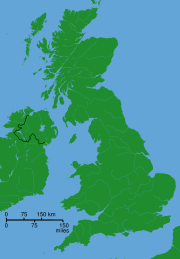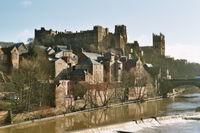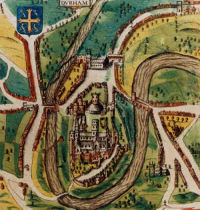Durham
2007 Schools Wikipedia Selection. Related subjects: Geography of Great Britain
| Durham | ||
|---|---|---|
|
|
||
| Statistics | ||
| Population: | 42,939 (2001) | |
| Ordnance Survey | ||
| OS grid reference: | NZ274424 | |
| Administration | ||
| District: | City of Durham | |
| Shire county: | Durham | |
| Region: | North East England | |
| Constituent country: | England | |
| Sovereign state: | United Kingdom | |
| Other | ||
| Ceremonial county: | Durham | |
| Historic county: | Durham | |
| Services | ||
| Police force: | County Durham | |
| Fire and rescue: | {{{Fire}}} | |
| Ambulance: | North East | |
| Post office and telephone | ||
| Post town: | DURHAM | |
| Postal district: | DH1 | |
| Dialling code: | 0191 | |
| Politics | ||
| UK Parliament: | City of Durham | |
| European Parliament: | North East England | |
Durham ( IPA: [ˈdɜɺəm] locally, [ˈdʌɹəm] in RP) is a small city and main settlement of the City of Durham district of County Durham in North East England. It is well known for its Norman Cathedral and Castle, and is home to Durham University. HM Prison Durham is also located close to the city centre. Prior to 1974 the city was sometimes known as Durham and Framwelgate.
Economy
This is a chart of trend of regional gross value added of County Durham at current basic prices published (pp.240-253) by Office for National Statistics with figures in millions of British Pounds Sterling.
| Year | Regional Gross Value Added | Agriculture | Industry | Services |
|---|---|---|---|---|
| 1995 | 4,063 | 47 | 1,755 | 2,261 |
| 2000 | 4,783 | 40 | 1,840 | 2,904 |
| 2003 | 5,314 | 39 | 1,978 | 3,297 |
- ^ Components may not sum to totals due to rounding
- ^ includes hunting and forestry
- ^ includes energy and construction
- ^ includes financial intermediation services indirectly measured
Geography
Durham is situated 13 miles (21 km) to the south west of Sunderland, in North East England. The River Wear flows north through the city, enclosing the centre on three sides to create Durham's "peninsula". Durham is a hilly city, claiming to be built upon the symbolic seven hills. Upon the most central and prominent position high above the Wear, the cathedral dominates the skyline. The steep riverbanks are densely wooded, adding to the picturesque beauty of the city. West of the city centre, another river, the River Browney, drains south to join the Wear to the south of the city.
Durham won the Large Town award in the Britain in Bloom awards of 2005.
The county town of County Durham, Durham is located in the City of Durham local government district, which extends beyond the city, and has a total population of 87,656, and covers 186.68 square kilometres. The unparished area of Durham had a population of 29,091, whilst the built-up area of Durham had a population of 42,939.
Durham's MP is Roberta Blackman-Woods ( Labour).
Transport
Durham railway station is situated on the East Coast Main Line between Edinburgh and London; rail travellers coming from the south enter Durham over a spectacular Victorian viaduct high above the city. By road, the A1(M), the modern incarnation of the ancient Great North Road, passes just to the east of the city. (Its previous incarnation, now numbered A167, passes just to the west.) Newcastle Airport lies to the north, and Durham Tees Valley Airport to the south, both being approximately 25 miles away. The Market Place and peninsula form the UK's first (albeit small) congestion charging area, introduced in 2002.
Districts of Durham
The centre of Durham sits on a peninsula created by the River Wear. At the base of the peninsula is the market square, which still hosts regular markets; a permanent indoor market is also situated on the square. The square and surrounding streets are one of the main commercial and shopping areas of the city. From the market square, The Bailey leads south past Palace Green: The Bailey is almost entirely owned and occupied by the University and Cathedral.
There are three old road bridges leading onto the peninsula, now all pedestrianised. Prebends Bridge is at the Southern tip of the Bailey. Heading east from the square, Elvet Bridge leads to the Elvet area of the city. Heading west, Milburngate Bridge leads to the Milburngate district, Crossgate and North Road, the other main shopping area of the city. West of here is an area colloquially known as "The Viaduct" after the structure which dominates, now largely student-populated. Beyond The Viaduct lies the outlying districts of Framwellgate Moor and Neville's Cross. Heading north from the market place leads to Claypath. The road curves back round to the East and beyond it lies Gilesgate and Gilesgate Moor.
History
Archeological evidence suggests a history of settlement at Durham since roughly 2000 BC. The present city can clearly be traced back to 995 AD, when a group of monks from Lindisfarne chose the strategic high peninsula as a place to settle with the body of Saint Cuthbert, that had previously lain in Chester-le-Street, founding a church there. The present Durham Cathedral was built from 1093, and still contains the remains of St Cuthbert as well as The Venerable Bede. It is regarded by many - such as travel writer Bill Bryson - as the finest cathedral in the world .
Facing the cathedral across Palace Green is Durham Castle, originally built by the Normans from 1071, on William the Conqueror's return from campaigning in Scotland. Some of the present structure is more recent, notably Anthony Salvin's Victorian restorations. The two buildings are jointly designated a UNESCO World Heritage Site- one of the original nine in Britain. Since 1837 the castle has been home to University College, the first college of the University.
In the three centuries following the construction of the Castle, Durham was regularly besieged by the Scots, with the notable Battle of Neville's Cross ( 1346) occurring just one mile west of the city.
In medieval times Durham was a major centre of both political and ecclesiastical power, mainly due to its strategic importance near the border with Scotland. County Durham was a palatinate, ruled by Prince-Bishops who had secular authority and considerable autonomy from Westminster, minting their own coinage, dispensing their own justice and with the right to maintain their own armies. Every Bishop of Durham from 1071 to 1836 was a Prince Bishop except for the first Norman-appointed bishop Walcher, who was an Earl-Bishop. (The term Prince Bishop, while a useful one, is not one which the Durham Bishops themselves would have recognised.) Henry VIII curtailed some of the Prince-Bishop's powers, and smashed the shrine of Cuthbert in 1538. Finally, the public climate surrounding the Great Reform Act of 1832 removed the Bishop's extraordinary powers.
In 1832 the University of Durham was founded, which has several buildings on the peninsula and on Elvet Hill on the other side of the river. The 19th century also saw Durham grow as a centre of the coal mining industry. The first Durham Miners' Gala was held in 1871, and remains a popular annual event.
The municipal borough was known as 'Durham and Framwelgate', until it was merged with Durham Rural District and Brandon and Byshottles urban district to form the City of Durham district.
Historic architecture
The whole of the centre of Durham is designated a conservation area. The conservation area was first designated on 9 August 1968, and was extended on 25 November 1980 . In addition to the Cathedral and Castle, Durham contains over 630 listed buildings , 569 of which are located within the city centre conservation area. Particularly notable properties include:
Grade I
- Chorister School
- Crook Hall
- Elvet Bridge
- Framwellgate Bridge
- Kepier Hospital
- Kingsgate Bridge
- Prebends Bridge
- St Giles Church, Gilesgate
- Church of St Margaret of Antioch, Crossgate
- Church of St Mary-le-Bow (now Durham Heritage Centre)
Grade II*
- Aykley Heads House (now Bistro 21)
- Bishop Cosin's Hall, Palace Green
- Cosin's Library (now part of University Library, Palace Green)
- Crown Court, Old Elvet
- St Cuthbert's Society, 12 South Bailey
- St John's College, 3 South Bailey
- St Oswald's Church
- Railway viaduct, North Road
- Town Hall and Guildhall, Market Place
Famous residents
- Barnabe Barnes Elizabethan poet
- Tony Blair Prime Minister of the United Kingdom (1997-present)
- Edward Bradley Novelist ('Cuthbert Bede')
- Count Joseph Boruwlaski Celebrated dwarf
- George Camsell International footballer
- John Bacchus Dykes Hymnologist
- John Meade Falkner Arms manufacturer and novelist (Moonfleet)
- Godric of Finchale Hermit and popular medieval saint
- Dora Greenwell Poet
- Josh Clarke Writer
- Canon William Greenwell Antiquary
- John Gully Pugilist
- Steve Harmison English cricketer
- Gareth Archer English rugby player
- Paul Collingwood English cricketer
- Ian Hay Novelist
- Lorna Hill Author of the 'Wells' ballet books
- Violet Hunt Novelist and 'new woman'
- Cyril Edwin Mitchinson Joad Philosopher and radio broadcaster
- Lawrence of Durham Poet
- William Pearson Watercolorist, Topographer
- 50 Pence International Comedy Rapper
- Anna Maria Porter Novelist
- Jane Porter Novelist
- Michael Ramsey, the 100th Archbishop of Canterbury
- Reginald of Durham Hagiographer
- Simeon of Durham Historian
- Christopher Smart Poet
- Joseph Spence Literary memoirist
- Anne Stevenson Poet
- Robert Surtees Historian and antiquarian
- Hugh Walpole Novelist
- Walter of Durham 13th century painter
- Sir Arnold Wolfendale Astronomer Royal
Town twinning
 Banská Bystrica, Slovakia
Banská Bystrica, Slovakia Durham, North Carolina
Durham, North Carolina Tübingen, Baden-Württemberg
Tübingen, Baden-Württemberg











